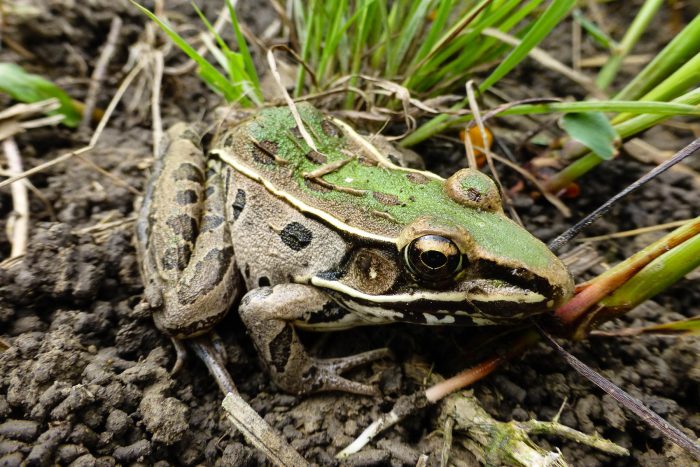Southern Leopard Frog
Lithobates sphenocephalus
The southern leopard frog is a medium-sized frog with spots on its back, sides and legs. Its leopard-like appearance was the inspiration for its name. It lives in wetland habitats in and can be found near the Chesapeake Bay in eastern Virginia, Maryland and southeastern Pennsylvania.
This section shows one large critter image at a time. Use the thumbnails that follow to select a specific image to display here.

This gallery contains a grid of small thumbnails. Selecting a thumbnail will change the main image in the preceding section.
Appearance
Southern leopard frogs are brown or green and typically grow to be between 2 and 3.5 inches in length. Females are larger than males. They have dark green to brown spots on their back, sides and legs that are rounded with light borders.
Adult frogs have two prominent yellow or gold dorsolateral folds extending from behind their eyes to their hips. Their heads are long and pointed. They often have a white spot in the center of their eardrum.
Their upper jaw has a light stripe that is sometimes yellow. Males have paired vocal sacs resembling small balloons on either side of their throats when they’re calling.
Feeding
Southern leopard frogs forage mainly on land. Insects make up the majority of their diet, but they also feed on arthropods and worms.
Predators
Like most frogs, southern leopard frogs are an important link in many food chains, and predators include great blue herons, river otters, grackles, southern water snakes, brown water snakes, northern black snakes, peninsular ribbon snakes and water moccasins.
Eggs and tadpoles are eaten by fishes, aquatic insects, salamanders, fishing spiders and other predators.
Voice
The southern leopard frog's sound resembles a short, chuckle-like, guttural trill followed by two or three "clucks." Some calls can sound like rubbing a hand back and forth over a rubber balloon.
Reproduction and life cycle
Southern leopard frogs breed from February to December with most of their breeding occurring between April and August. Breeding frogs typically gather in large groups. Once fertilized, eggs are attached in clusters of several hundred to vegetation just below the surface of the water.
Breeding frogs typically place many egg clusters in a small area. Eggs hatch within one to two weeks. Tadpoles feed on algae and other organic material and metamorphosis occurs after about three months.
Did you know?
- The taxonomic status of leopard frogs has been widely debated. Once regarded as one species (Rana pipens), they are now seen as a large group made up of distinct species.
- Lithobates sphenocephalus is Greek. Litho means “a stone;” bates means “one that walks or haunts;” sphenocephalus means “wedge headed.”
- The common name, southern leopard frog, comes from the frog’s spots, which are reminiscent of leopards’ spots.
- Urbanization, loss of habitat and water pollution have reduced or eliminated some local populations of southern leopard frogs, but they are adaptable and continue to thrive where there is relatively clean water.
- The southern leopard frog is the most common true frog on the Coastal Plain.
- The largest known southern leopard frog was five inches long.
- Southern leopard frog eggs can hatch earlier than normal if predators are nearby.
Sources and additional information
- Field Guide to Maryland’s Frogs and Toads: Southern Leopard Frog – Maryland Department of Natural Resources
- Southern Leopard Frog – North Carolina Wildlife Profiles
- Southern Leopard Frog – Savannah River Ecology Laboratory
- Frog Friday: Southern Leopard Frog – Virginia Department of Wildlife Resources
- Reptiles and Amphibians of Virginia: Southern Leopard Frog – Virginia Herpetological Society
- Animal Diversity Web: Rana sphenocephala – University of Michigan
